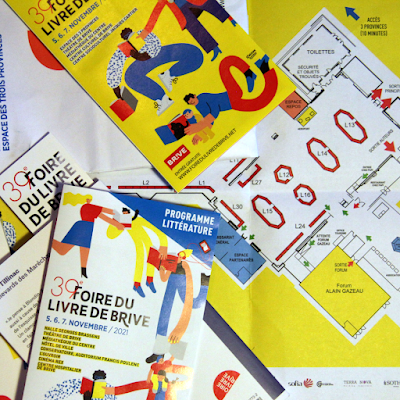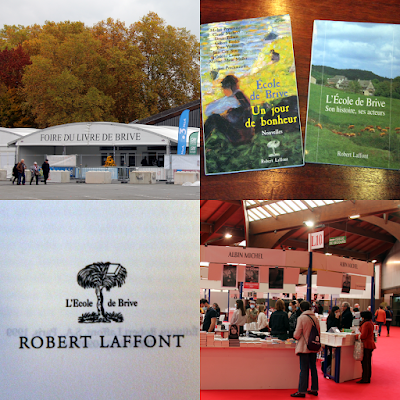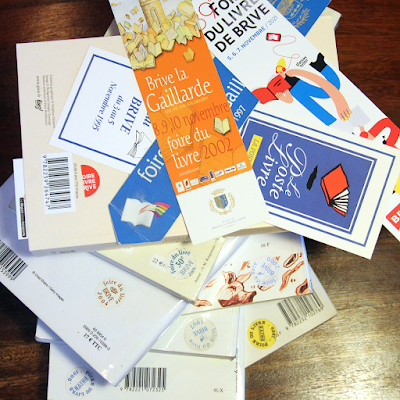 |
The posters,bookmarks and leaflets were reprinted, the stickers had a whiff of ‘country’ this year. |
First time I came across l’École de Brive was in Claude Michelet’s (1981); ‘Mon Père, Edmond Michelet’, on the life of his father; resistance leader of the first hour, Dachau survivor, legislator and multiple times minister under various governments/cabinets (1945, 1958, 1959, 1967, 1968 and 1969). Before the second world war he married and settled in Brive (his wife’s place of origin), were he became an active member of local Catholic and social initiatives and formed a group of friends to study, discuss and invite speakers from outside. It became locally known as ‘l'École de Brive
 |
The Foire du livre de Brive and the École de Brive. |
Maybe (or maybe not) the name was bound to reemerge when a new group formed around his son, 'farmer by day / writer by night', Claude. Neither a ‘school’ in the artistic sense nor literal sense of the word, it might be a ‘school of thought’ but mostly is a group of like minded friends (bande). In the book ‘L’Ecole de Brive, Son histoire, ses acteurs’ (Editions Laffont, 1996), Jacques Peuchmaurd (working for the publisher Robbert Laffont) tells the story of a series of encounters with writer Michel Peyramaure, by which he saw emerging this band.
So there this ‘fabulous director of the past’ who since 1954 had published a long list of historical novels; Michel Peyramaure. Jacques accompanied him to a book signing event at the open metallic market hall of Guierle in Brive, 1973. Jacques had been tasked by Laffont to work on a series ‘Un homme et son métier’, when they ran into Claude Michelet. Michel told him that this would be the guy if he was looking for a farmer for his series. So in 1975, ‘J’ai choisi la terre’ came out and sold 30.000 copies! A few years later ‘Des grives aux loups’, was expected to do equally well … it sold millions.
 |
One of the 1.200 dedicated copies of his Marie des brebis and the lasted and last novel of Tillinac. |
By 1984 Christian Signol joined, in 1989 Gilbert Bordes, it was around this time the term ‘École de Brive’ (re)surfaced for this band of local writers reviving the great romantic and popular tradition of the nineteenth century. The Foire du livre de Brive became an event on the cultural calendar, a special ‘train du livre’ left Paris-Austerlitz carrying ‘a swarm of editors, academics of all kinds, critics and authors... returning to Paris on Sunday evening with rosy cheeks and alarming rates of chlosterol’*. Michelet signed 1.900 copies of ‘L’Appel des engoulevent’ in 1990, a few years later Signol dedicated 1.200 copies of his ‘Marie des brebis’. The 1990’s saw an acceleration of a social movement towards ‘La France profonde’, people started to retire earlier and earlier towards their village of origin.
 |
Meet and greet the local authors… |
That remains an interesting contradiction that is well represented within the École de Brive, Michelet gave up his farm to write. Peyramaure, Tillinac, Bordes all ‘localliers’; journalists paid to live in the country. Laussac, Muller, Soumy, Viollier all on a teaching salary. Living in the country is great, as long as you do not have to make a living there… This year (2021) the 39th Foire du livre de Brive was held, had to skip a year due to COVID. The posters, bookmarks and leaflets were reprinted, the stickers had a whiff of ‘country’ this year.
 |
The stickers had a whiff of ‘country’ this year,looking forward to the big 40th |
Dauzier P. et Tillinac D., 1991. Les Corréziens. Éditions Robert Laffont. ISBN 2-221-07232-4


